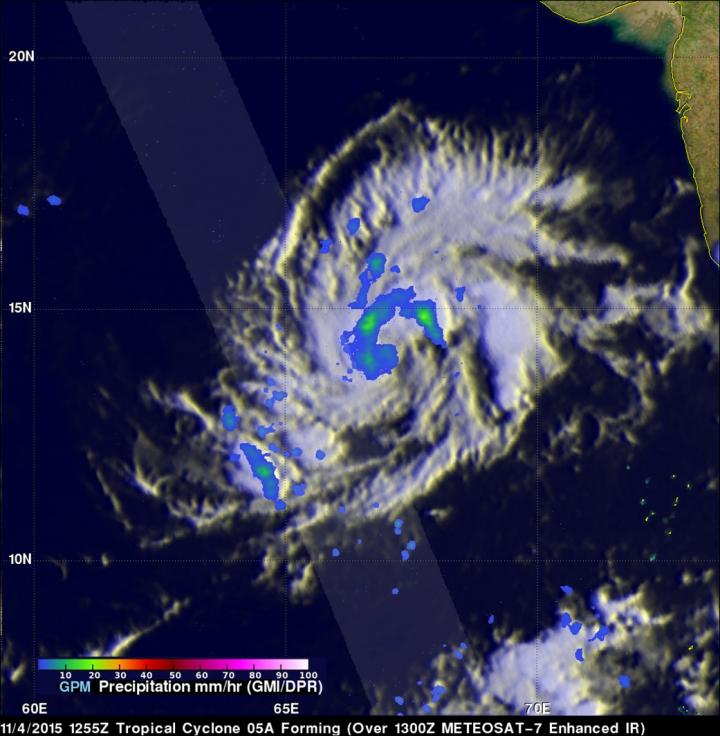NASA spots another Arabian Sea tropical cyclone forming

NASA/JAXA's GPM satellite measured scattered light to moderate rainfall in Tropical Cyclone 05A on Nov. 4, falling at a maximum rate of only 23.3 mm (.92 inches) per hour. Credits: NASA/JAXA/SSAI, Hal Pierce
Deadly tropical cyclone Chapala had just dissipated over Yemen when tropical cyclone 05A started forming in the warm waters of the Arabian Sea west of India.
GPM measured the rainfall within the forming tropical cyclone using the satellite's Microwave Imager (GMI) and Dual-Frequency Precipitation Radar (DPR) instruments. GMI and DPR found that 05A had scattered light to moderate rainfall falling at a maximum rate of only 23.3 mm (.92 inches) per hour.
GPM is an international mission led by NASA and the Japan Aerospace Exploration Agency to observe rainfall and snowfall around the world. The program is managed by NASA's Goddard Space Flight Center in Greenbelt, Maryland.
On November 5, 2015 at 1500 UTC (10 a.m. EST), Tropical Cyclone 05A was located near 13.9 degrees north latitude and 63.9 degrees east longitude, about 546 nautical miles (628.7 miles/ 1,012 km) east of Socotra Island, Yemen.
Tropical Cyclone 05A is moving to the west at 10 knots (11.5 mph/18.5 kph). It is a tropical storm with maximum sustained winds near 35 knots (40 mph/64.8 kph).
The tropical storm is expected to track over the island of Socotra on Nov. 8 with tropical storm force winds while heading west.
The Joint Typhoon Warning Center (JTWC) predicts that 05A will head toward Cape Gardafui, Somalia, move into the Gulf of Aden and make landfall in southeastern Yemen north of Aden, Yemen on Nov. 10.
Media Contact
All latest news from the category: Earth Sciences
Earth Sciences (also referred to as Geosciences), which deals with basic issues surrounding our planet, plays a vital role in the area of energy and raw materials supply.
Earth Sciences comprises subjects such as geology, geography, geological informatics, paleontology, mineralogy, petrography, crystallography, geophysics, geodesy, glaciology, cartography, photogrammetry, meteorology and seismology, early-warning systems, earthquake research and polar research.
Newest articles

Sea slugs inspire highly stretchable biomedical sensor
USC Viterbi School of Engineering researcher Hangbo Zhao presents findings on highly stretchable and customizable microneedles for application in fields including neuroscience, tissue engineering, and wearable bioelectronics. The revolution in…

Twisting and binding matter waves with photons in a cavity
Precisely measuring the energy states of individual atoms has been a historical challenge for physicists due to atomic recoil. When an atom interacts with a photon, the atom “recoils” in…

Nanotubes, nanoparticles, and antibodies detect tiny amounts of fentanyl
New sensor is six orders of magnitude more sensitive than the next best thing. A research team at Pitt led by Alexander Star, a chemistry professor in the Kenneth P. Dietrich…





















